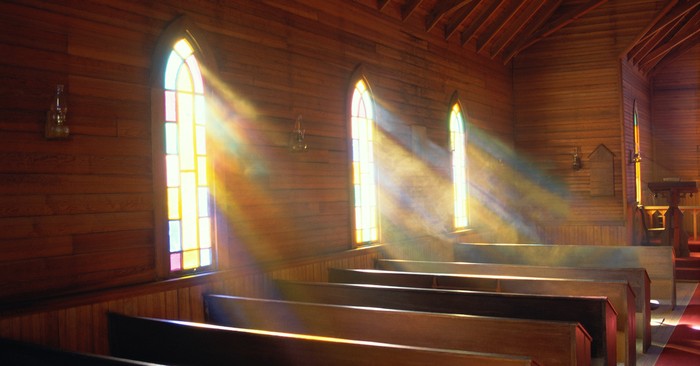
What do you picture when you think of church?
Do you think of the rows of wooden pews or the intricate stained-glass windows in the sanctuary? Stacks of Bibles and hymnals? What about a stage or pulpit? Maybe you think of a large auditorium setting if you attend a mega church.
All these details tell us what we see when we look at a building, but they tell us nothing about what a church should biblically look like. Scripture does not give directions about the format of seating or the use of a stage. We find no mention of a required carpet color or use of stained-glass windows. During the early days of the church, there were no chapels or cathedrals with steeples. That is because the Church is not a building.
Believers make up the body of Christ, the Church (1 Corinthians 12:27).
As members of the body of Christ, what we look like stems from our relationship to Jesus and the mission He gave us. He has called us to be a multiplying people, a community that grows and reaches into the lives of others. It is a group of individuals who increasingly look like Him.
C.S. Lewis wrote about the purpose of the church in Mere Christianity. As he explained, “[T]he church exists for nothing else but to draw men into Christ, to make them little Christs. If they are not doing that, all the cathedrals, clergy, missions, sermons, even the Bible itself, are simply a waste of time” (HarperOne, 2001, p. 199).
At first, Lewis’ statement might surprise us. Constructing buildings, doing missions, and studying the Bible are wastes of time? They are if people are not growing in Christ and making disciples. The body of believers is meant to look increasingly like Jesus and help others become reflections of Christ too. If the church is not doing that, then it is not accomplishing its purpose. It will not look like a biblical church.
But what are the indications that a group of believers are accomplishing this purpose of growing to become more like Christ?
Scripture does not have directions about what a church building should look like, but it does have a wealth of information about what it looks like to live as individuals belonging to the Church.
Photo credit: ©Getty Images/Will & Deni McIntyre

1. Devoted to Biblical Teaching
The biblical model for what the Church should look like as the body of Christ is best shown in Acts 2 with the early Church. After receiving the indwelling of the Holy Spirit, Peter gave his famous Pentecost sermon (Acts 2:1-40). Over 3,000 people placed faith in Christ and were baptized as a result of that sermon, adding to the number of the Church (Acts 2:41).
Directly after this account, we read about how the Church lived in daily life. According to Acts 2:42-43, “They devoted themselves to the apostles’ teaching and to fellowship, to the breaking of bread and to prayer. Everyone was filled with awe at the many wonders and signs performed by the apostles.” Many important things are mentioned, but the first is that the new believers were devoted to the teaching of the Apostles, which was corroborated by wonders and signs.
At that time, the New Testament had not yet been written. However, we know that the teachings of the Apostles would have come directly from what Jesus had taught them. They were following His instructions by making disciples and teaching the new Christians to obey everything the Lord had commanded (Matthew 28:18-20).
Today, the equivalent of being devoted to the Apostles’ teachings is to study and obey Scripture. Notice that the word used in Acts 2:42 is “devoted.” We should not just read the Bible passively but listen intently and seek to do what it says (see James 1:22).
A distinguishing marker of the biblical Church is a devotedness to knowing and following Scripture, just as the early believers did.
Photo credit: ©Getty Images/Robyn Hodgson / EyeEm

2. A Praying People
Another thing the Bible tells us the Church should look like is that we should be a praying people. We see this emphasis on prayer modeled in the early Church. In Acts 2, the new believers are described as being devoted to prayer, just as they were devoted to the teachings of the Apostles (Acts 2:42). The Apostles had already demonstrated the need to pray regularly, as did the men and women who were with them (see Acts 1:14).
When they prayed, they did not ask God for safety or prosperity. Instead, they asked for boldness to continue to speak God’s Word (Acts 4:29). This prayer occurred directly after Peter and John were imprisoned and persecuted for talking about Jesus. The church would have had legitimate reasons to be afraid and seek safety. Yet, they chose to pray for boldness to continue in faithful service to the Lord.
He answered their prayers. By the power of the Holy Spirit, they continued to speak the word of God with boldness (Acts 4:31). Likewise, the Apostles did not stop talking about Jesus’ resurrection (Acts 4:33).
To look more like a biblical church, we should be making these types of prayers. More than desiring our safety or comfort, we should desire to do the will of Christ. As a people devoted to prayer, our prayers should be much more than words we mouth on a Sunday morning. We should be steadfastly committed to interceding for others and asking God for strength to serve Him and make Him known.
Photo credit: ©Getty Images/SDI Productions

3. Loving One Another
Jesus told His disciples, “A new command I give you: Love one another. As I have loved you, so you must love one another. By this everyone will know that you are my disciples, if you love one another” (John 13:34-35). A distinguishing mark of the Church, therefore, is love for others, especially those belonging to Christ.
An emphasis on love shows us why the early Church committed themselves to fellowship and having all things in common (see Acts 2:42, 44; 4:32). They were called to love each other, not just by word, but by deed (1 John 3:18). The early believers met for meals and friendship (Acts 2:46). They also ensured everyone was provided for (Acts 4:34-35). In essence, they were like a large family knit together by a common love for Christ and each other.
From a scriptural view, love should be a recognizable trait of the body of Christ. We cannot rightly claim to belong to the family of believers if we have no love for others. Those who have been redeemed and transformed will love their brothers and sisters in Jesus (1 John 3:14; 4:20).
In the church today, we need to stop thinking that people will recognize us as disciples of Christ because we visit a building every Sunday. The Church is recognized for its love. Biblically, this love is far more than saying nice words or calling congregation members “brother” and “sister.” Loving others includes action, such as providing fellowship and ensuring that the family of believers has what is needed.
Photo credit: ©Getty Images/Fred Froese

4. Sharing with Others
As was shown in the previous point, a church that loves ensures that the family of Christ is provided for. Related to this aspect is sharing with others. A biblical church shares resources and spiritual gifts with others so that none are lacking or struggling.
The Apostle Paul gave the example of a body to describe the Church (1 Corinthians 12:12-31). Each member or part is needed for the body to properly function. When one part suffers, the others suffer too (1 Corinthians 12:26). Christians should use their gifts and resources to benefit the other members of the body of Christ (Romans 12:4-8).
In Paul’s day, the Macedonia church applied this principle. Hearing about the believers struggling with poverty in Jerusalem, they gathered money to send as aid for what the church was lacking, even though they were also poor (see Romans 15:25-26 and 2 Corinthians 8:1-5). They shared what they had and used it in service to the Lord (2 Corinthians 8:4).
Paul encouraged the Corinthians to do the same. As he wrote, “At the present time your plenty will supply what they need, so that in turn their plenty will supply what you need. The goal is equality” (2 Corinthians 8:14).
Sharing as an act of service also resembles our Savior, because He came to serve and give His life to save us (Matthew 20:28).
We all have resources and spiritual gifts that we can share for the benefit of the Church and to help others look more like Christ. A biblical church shares openhandedly and for the good of others.
Photo credit: ©Getty Images/Daisy

5. Caring for the Poor and Least of These
The Bible also tells us that the Church should look like people caring for the poor and the least of these. In the days of the early Church, believers sold their possessions and property to give to anyone in need (Acts 2:45). They followed Jesus’ words, knowing that it was more blessed to give than to receive (Acts 20:35).
Caring for orphans and widows was also a significant part of the early Church. The Apostles entrusted the important ministry of providing for widows to seven men, one of whom was Stephen (see Acts 6:1-6). Later, Paul also emphasized the need for a system of ministering to widows (1 Timothy 5:3-10).
True religion means putting faith into practice and caring for orphans and widows (James 1:27). It also looks like helping the least of these, through feeding the hungry, giving the thirsty water to drink, clothing the naked, helping the sick, and visiting those in prison (Matthew 25:34-40). Others should be able to know that we are members of the body of Christ through our care and concern for the least and poor in society.
Although so many of us know these verses in the Bible and are familiar with the need to put faith into action, how many of our churches are doing so? Today, some in the body of Christ wrongly perceive these actions as “liberal” or part of following a social agenda. As evidenced from the early Church though, caring for the needy, orphaned, and widowed is biblical and a distinguishing mark of the church.
We might have everything else right, such as meeting regularly to worship the Lord, read Scripture, and pray. However, if we are not living out our faith, we are not fulfilling the purpose of being the Church. A biblical church reaches out to those who are poor and in need.
Photo credit: ©Getty Images-fhm

6. Adorned with Righteous Deeds
In addition to helping those in need, Scripture also tells us that the Church should look like a bride adorned for a wedding. The church is the bride of Christ. He died to purify her and make her clean. At Jesus’ return, the Church will be adorned in bright and clean linen for the wedding supper of the Lamb (Revelation 19:7-8).
The Apostle John explained that the wedding dress of the bride – the bright and clean linen – is a symbol of the righteous deeds or acts of believers (Revelation 19:8). Virtuous deeds do not save us, as it is Jesus’ blood that makes us clean (Ephesians 5:25-27). However, the righteous acts we do now will adorn us at the wedding feast. The Church will be dressed and ready for her Husband.
We can thank Jesus, though, for the ability to adorn ourselves on that day. After salvation, we are given works to do, which the Lord prepared in advance for us (Ephesians 2:10). These deeds enable us to collectively sew and prepare our wedding dress of fine linen for that glorious day.
Today, people should be able to distinguish members of the Church by their good works. Believers are not perfect and will stumble at times. However, we were saved and made into God’s workmanship, created to do good works and increasingly reflect our loving Savior. The righteous acts we do testify to others that we are part of the body of Christ.
The Church should look like a bride keeping herself pure for her husband and preparing herself for the anticipated wedding day.
Photo credit: ©Getty Images/RunPhoto

7. A Multiplying People
Finally, and most importantly, the church is meant to be a multiplying people. The body of Believers should be like the seed that landed on good soil, which produced a crop that increased by a hundred, sixty, or thirty times that which was sown (see Matthew 13:23). We should multiply in number as we make disciple-making disciples.
Jesus gave us the Great Commission, commanding us to go out into the world to make disciples of all nations (Matthew 28:19). The early Church obeyed this command, adding to their number daily of those who placed faith in Jesus (see Acts 2:41, 47; 4:4). The disciples were multiplying, spreading like wildfire. Even when persecution came, causing the Church to scatter to other areas, Christians continued to spread the gospel and make disciples (see Acts 8:3-4).
The Church’s purpose is to make disciples, or, in the words of C.S. Lewis, little Christs. We meet and worship at weekly gatherings, not to mark off a checklist of spiritual duties, but to grow in Christ and become equipped to make disciples (see Ephesians 4:12). If a congregation of believers is not accomplishing that goal, then it does not biblically look like the Church.
People should not have to go to a church building to hear the gospel or encounter the loving action of a believer. The Church should go to them, just as Jesus commanded. We look most like the Church when we live as multipliers, going and helping others know Jesus and become disciples.
To identify the Church, we need not look for a building. True members of the body of Christ will be known by their lives, defined by love for Christ and others.
Related Resource: A Prayer for Church Hurt
This prayer for church hurt is based on Psalm 94:19. Listen in and pray with us! Be sure to subscribe to Everyday Prayers on Apple or Spotify to get every episode straight to your phone daily!
Photo credit: ©Getty Images/Dmytro Varavin
Originally published Wednesday, 20 March 2024.









